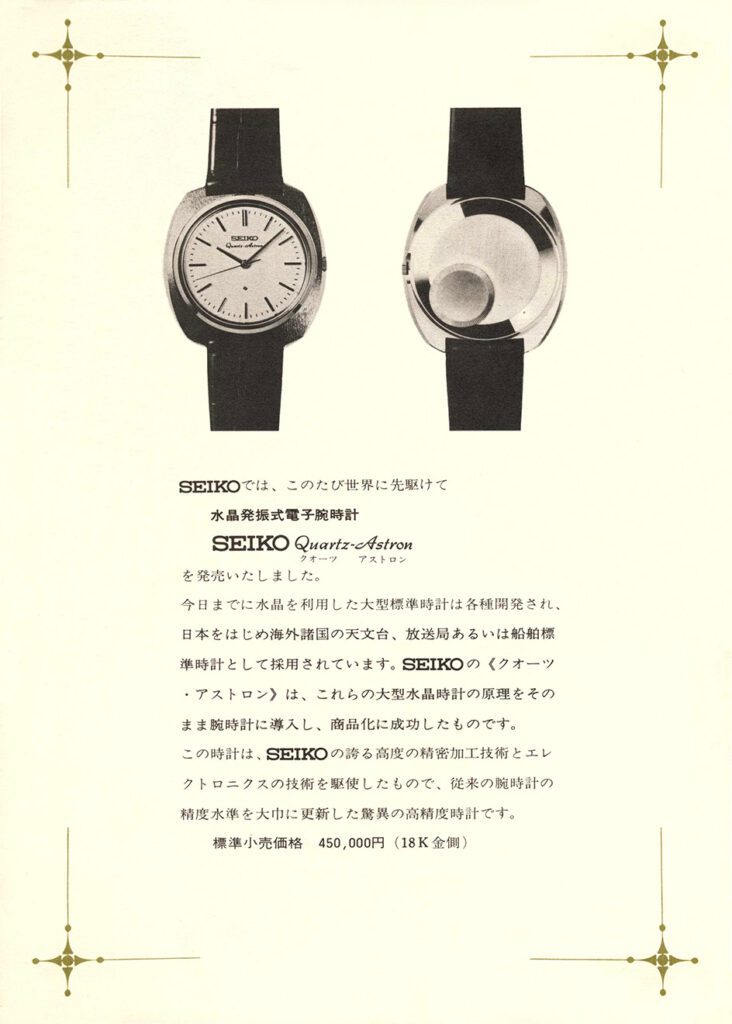10 Things About Seiko You (Probably) Didn’t Know
1. Tokyo
Seiko was founded in 1881 in Tokyo, Japan by 21 year old Kintaro Hattori. Initially, the company was known as K. Hattori & Co. – a small watch and clock repair shop, but it gradually expanded into a full-fledged watch manufacturing business eventually becoming one of the world’s largest watch manufacturers.
2. Quality

Seiko is known for its high-quality and innovative watches. In fact, the company is credited with introducing the world’s first quartz watch in 1969, which revolutionized the watch industry. In 1968, K. Hattori’s President, Shoji Hattori, told his team that he wanted them to achieve the commercial release of a quartz watch within one year. The result? The Seiko Quartz Astron 35SQ, released December 25, 1969, at a price of 450,000 yen, which changed the world. With 100 times the accuracy of a standard mechanical watch, accurate to within ±5 seconds per month – it was the watch that launched the quartz movement that would eventually bring accurate timekeeping within the reach of all which, in turn, led to the worldwide manufacturer’s quartz crisis.
3. Wide range
Seiko produces a wide range of watches, including mechanical, quartz, GPS and kinetic watches. Kinetic watches are a hybrid of mechanical and quartz watches, launched at Switzerland’s Baselworld, in 1986. Originally known as the A.G.S., or Automatic Generating Quartz – the Kinetic has an oscillating weight which converts the wearer’s motion into electricity which powers the quartz movement. The generated electricity is stored in a rechargeable battery that requires replacement less frequently than the conventional cell battery in a quartz watch.
4. Olympics
Seiko is also known for its precision timekeeping. The company has been the official timekeeper for several Olympic games, including the 1964 Tokyo, Japan Olympics, known as the first-ever Olympics to be broadcast live by satellite. The three Seiko Group companies (Seikosha Clock Factory, Daini Seikosha and Suwa Seikosha) produced a total of 1,278 timers, clocks, and stopwatches, as well as a thorough marketing effort to promote their brand to the world. The vast exposure vaulted the company and generated a global sales expansion for Seiko products.
5. Vertical
Seiko is a vertically integrated company, which means that it controls every aspect of the watchmaking process, from designing and manufacturing the components to assembling the final product. Since as early as 1910, Seiko makes all parts for their timepieces: the cases, the dials and every aspect of the movement – all done in-house, with thorough control of quality, delivery dates, and cost.
6. Several brands
Seiko has several watch brands under its umbrella, including Grand Seiko (premium), Seiko Astron (GPS solar watches), Seiko Prospex (dive watches), Seiko 5 Sports (performance watches), Seiko Diamond Collection and Seiko Presage and King Seiko (mechanical watches with high accuracy). Each brand is designed for a specific market segment, with Grand Seiko being the most high-end and luxurious timepieces made by master craftsmen in Seiko’s two exclusive watchmaking studios, using exclusive movements with the highest grade materials.
7. Reduce
Seiko is committed to sustainability and has set several targets to reduce its environmental impact. For example, the company aims to use 100% renewable energy by 2030 and reduce its CO2 emissions by 50% by 2030. In 2021, the brand switched to renewable electricity at all their domestic plants and offices. They’ve also adopted the TCFD recommendations, of which there are 11, to demonstrate the sustainability of their business operations.
8. Arms Race
By the end of WWII, all Seiko factories were destroyed, except for one—their Suwa Seikosha factory. Over the next decade, Seiko rebuilt its Daini Seikosha factory. Having both Suwa and Daini as separate entities of the same brand would become a company-wide attempt to promote healthy competition in design. Thus came the battle for supremacy between two separate subsidiaries of Seiko, in the year 1959. The most notable competition between the two divisions of Seiko was the push and pull between the ‘Grand Seiko’ from Suwa and the ‘King Seiko’ from Daini. Ultimately, Suwa won out regarding the most popular Seiko styles. Their designs are still leaned upon the most—in terms of today’s sales. However, many Daini watches have made it to market and are favorite pieces to a sizable group of watch collectors.
9. Competition
In 1959, the Neuchâtel Swiss Observatory opened up to entrants from outside of Europe – testing the world best chronometers for 45 days. In their first year of their competition, in 1963, Seiko entered Suwa-Seikosha in the wrist watch category placing in 144th position. In their second year, Seiko also entered Daini-Seikosha in the wrist watch category placing in 153rd position. In just 5 years, Seiko Suwa factory had increased to 12th position while the Seiko Daini factory had increased to 4th place. With potentially threatening Seiko victories, in 1968, the Geneva Observatory cancelled its contest as Swiss brands threatened to boycott, the Swiss Observatory competitions were suspended and never revived.
10. Television
At 2:00 p.m. on February 1, 1953, the first television signal was transmitted in Japan which started as the The Tokyo Television Opening Ceremony and a speech by Furukaki Tetsuro, president of the NHK. Seeing an opportunity and adding to their rich history, Seiko quickly got involved by showcasing a ‘Comet Flower’ alarm clock featured in the first TV commercial aired in Japan, on August 28th, 1953 at 7 pm, immediately following the hourly signal on the station, Nihon TV.

